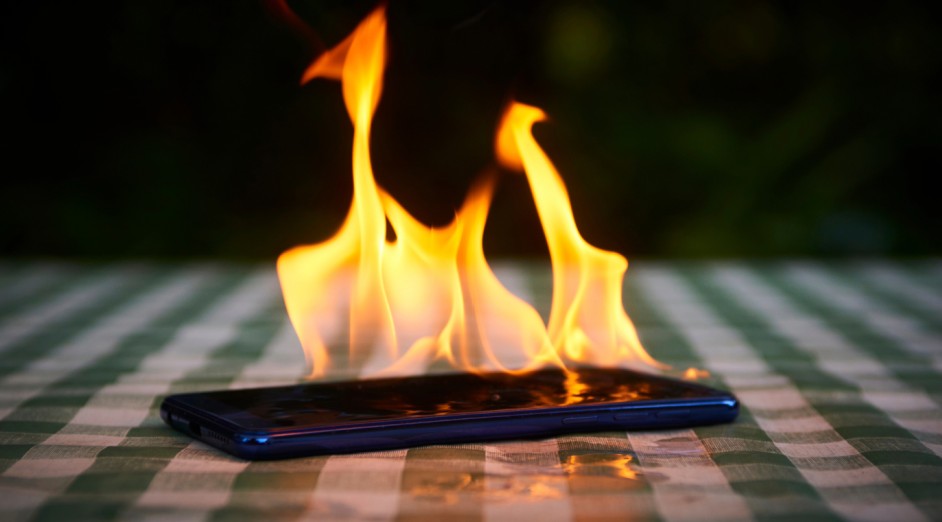Every day we hear of yet another lithium-ion battery fire, most of which cause devastating and total loss to homes, apartments and even garbage trucks and facilities.
CyberShack has written much about this, so have a read if you need to know more.
- Warning – 164 Lithium-ion battery fires in 6 months in NSW alone
- Large Lithium-Ion battery fires are a risk too far
- Planes and power banks – FAA/TSA rules enforced
- Virgin battery bank fire – a rethink about banning them
- Spontaneous car fires. Is your smartphone or laptop to blame?

The bottom line is that fires, even from smaller lithium-ion batteries under 100Wh (as you would find in a laptop or battery bank), are occurring daily. We won’t repeat the warning, but at least read Is there a safe way to charge Lithium-ion batteries?
And a lithium-ion fire is unlikely to be covered by fire insurance.
Lithium-ion battery fire: Advice for renters, home and strata owners
Lithium-ion devices are here to stay. They are the most cost-effective, energy-dense rechargeable batteries in everything from vapes to home solar batteries. There are far safer alternatives like Lithium Iron Phosphate (LiFePO4 or LFP), and some companies now offer these. But 100% safe rechargeables are still a decade away.
Our advice covers
- Charging.
- Transporting.
- Renting and strata template policy.
Charging
Most fires occur during charging, ergo, don’t charge near flammable materials.
The simplest solution is to charge on a ceramic tile (you can get 30 x 30 and 60 x 30 cm tiles for well under $20 per m2 from any hardware store). It is fireproof and insulates whatever it is sitting on.
But Lithium-ion fires can ‘explode’, sending hot metal through the air, so the best is to make a fireproof box. Again, look at ceramic tiles and a bit of silicon sealant, and you can create a sturdy fireproof box. A lid can be another lift-off tile.

Some are using metal toolboxes from $15 to $65, but while these are excellent for charging, they don’t insulate, and it’s wise to line them with ceramic tiles.
The best advice for new builds is to allow space for a ‘device room’. This is lined with fireproof Villaboard, has a fire-rated door, and is on a separate power circuit with a master switch at the door. Read Smart homes need a smart design – more power and better connectivity.
Rule #1 – Charge in a safe place!
A laptop or smartphone can spontaneously erupt, and again, consider using these on non-flammable surfaces to prevent the spread of fire.


Rule #2 – Use in a safe place
Transporting
Few fires are caused by transport. It is more about leaving laptops and phones in a hot car. Read Spontaneous car fires. Is your smartphone or laptop to blame?
We recommend an insulated chiller box, but these are flammable. They are great for keeping lithium-ion powered laptops and devices cooler in locked cars.

Fire melts PU sleeves and laptop bags – these only add fuel to the fire. Some are insulated and fireproof (you don’t want fire retardant) briefcases, document pouches and bags.

Rule #2 – get a proper transport case
Renting or part of a strata?
If you rent a property, are an investor with a rental property or part of a strata, we have bad news – insurance generally does not cover Lithium-ion fires. Read Does insurance cover a lithium-ion battery fire? Maybe, and probably not.
It all comes down to a ‘duty of care’, and lithium-ion fire insurance claims are too easily rejected because due care was not exercised.
Renters take on 100% liability for a fire, but the catch-22 is that the property owner must have issued a firm policy on the use of Lithium-ion devices, or they are just as liable.
The same goes for strata’s owners, whether residents or renting out the property. There must be a clear and irrefutable policy clearly posted and publicised.

Following is a widely accepted policy that only requires the approval of the strata committee and distribution to all owners and renters. In effect, it passes the duty of care to the occupier.
Feel free to add or change according to your needs, but make sure your occupiers and rental managers are aware of it.
Standard policy applicable to all Battery categories

This applies to any embedded, replaceable, rechargeable or single-use Lithium-ion or similar technology, hereinafter referred to as Battery.
- The Body Corporate (or its nominee) may
- Vary Watt Hours (Wh) or equipment classifications in response to advances in battery technology or charging, and a simple motion at an AGM or EGM shall ratify any variations.
- Exercise reasonable discretion in the enforcement of this policy, but not in any way that would intentionally affect its insurance or cause harm to property or life.
- The manufacturer’s original charger must be used and have an Australian RCM (Regulatory Compliance Mark) or R-NZ C-Tick certification. Where a charger is not provided, a quality, certified charger of the appropriate voltage and amperage must be used.
- An Australian Standard AS3504 fire blanket capable of covering the device must be located within 3 meters of any device while charging.
- Must be charged at least 2 meters away from flammable items and on a non-flammable surface.
- The device must be removed from the charger when charged, except for items charged on a dock with battery management and disconnect technology.
- The device must never be left unattended when charging, but regular 30-minute inspections are acceptable. Such inspections must check for heat from the item, and if it exceeds 50° (hot to touch), it must be disconnected, not used and reported immediately to Body Corporate.
- In the event of battery smoke or fire, immediately call 000, remove (if safe) to an outside driveway area, and attempt to locate Body Corporate as soon as practical.
- Ignorance of this policy or breach of any part of it results in all liability resting on the property owner or, if tenanted, the leasee.
- Compliance with the policy for guests rests on the property owner or, if tenanted, the leasee.
- Breach of this policy constitutes grounds for terminating a lease and full cost recovery for restoring the fire-affected area.
- Tenants and owners have a duty of care to reduce the potential for battery fires.
Embedded in vapes or disposable items
Smoking or vaping inside any property is prohibited.
Disposal of items like vapes or items where removable or embedded Batteries are present
- Must not be placed in the complex’s rubbish bins
- Must be properly recycled via a battery recycling drop-off box at most supermarkets, Officeworks, Bunnings, IKEA, or the place of purchase.
Less than 100Wh – in-home charging
These include smartphones, laptops, portable power banks, robot or powered vacuum/mops, children’s toys, cooking appliances, or other items approved by Body Corporate, which may be charged in your apartment, provided:
- Charged at least 2m from flammable materials like carpets, drapes, bedding, furniture, or floor coverings on a non-flammable surface. Charging devices on stone benchtops or ceramic tiles is recommended.
100-200Wh – garage charging only
These include portable tools, small portable power banks and smaller consumer or industrial items. They may be charged in the parking garage or driveway, provided:
- Charged at least 2 metres from flammable items.
- May be stored in the garage when disconnected from a charger
200-500Wh – outdoor or driveway area only
These include any e-bike, e-scooter, e-hoverboard, or e-mobility item, larger tools, and portable power banks, regardless of Wh. When disconnected from the charger, they may be stored in a parking garage.
- Charged directly in front of your garage and minimises access issues for other residents.
Electric vehicles – any Wh
- Charged in your garage using a 240V/10A/2400W wall plug or certified EV charger, provided flammable materials are suitably protected.
- Charged at the commercial EV Charger.









2 comments
Barrie Markey
Hi Ray,
Good to see you are still active .
Your article was perfect timing as we have our first EV in our apartment block so have sent your information to owners and Body corporate to see what our insurance covers.
Am enjoying retirement while Sarah is busy still working in what is now a tougher industry.
I am sure we had the best of it !
Cheers
Barrie Markey
Ray Shaw
Great to hear from a living doyen of the industry. I hope you are well and thriving – we are.